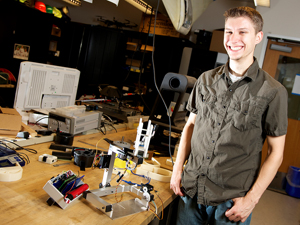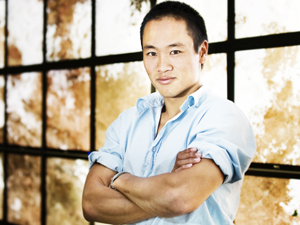UCSD Undergrad's National Geographic Collaboration Leads to Internship
By Chris Palmer, 858-534-4763, or crpalmer@ucsd.edu
San Diego, Calif., June 9, 2011 -- Like many undergraduate students, Alan Turchik's academic journey has been full of random twists and turns. So, it is no wonder that he spent the past year building a collection of sensors and motors to counteract random twists and turns.
|
A graduating senior in mechanical engineering in the University of California, San Diego's Jacob's School of Engineering, Turchik has been working with the National Geographic Society (NGS) to develop a stabilization mechanism for a camera mounted to an aerial platform that takes bird’s-eye view photos of archaeological dig sites. Turchik’s camera platform project was one of the first two funded by the UCSD-NGS Engineers for Exploration program, a two-year old collaboration between NGS and the UCSD division of the California Institute for Telecommunications and Information Technology (Calit2) that enlists teams of UCSD undergraduates from a variety of disciplines to develop ruggedized systems and devices for NGS projects.
Like so many aspects of Turchik’s academic career, his introduction to the intersection between engineering and archaeology occurred on a whim. Friend and fellow mechanical engineering student, David Hernandez, called him up in his junior year and asked Turchik if he wanted to go to Jordan to assist with a dig headed by Thomas Levy, professor and Norma Kershaw Endowed Chair in the Archaeology of Ancient Israel and the Neighboring Lands at UCSD and associate director of the Center of Interdisciplinary Science for Art, Architecture, and Archaeology (CISA3
The dig was to start ten days later. "Dave said I had four hours to decide, so I just went for it," said Turchik, who is also a sergeant in the US Army Reserve. Ten days notice for a two and a half month-long foreign desert expedition was no sweat. "I have my passport and deployment 'go' bag packed and ready at all times," he added.
Once in Jordan, Turchik’s first encounter with the aerial camera platform he would eventually redesign was turbulent. In its initial iteration, the camera platform system, normally tethered to the ground and held aloft with a helium balloon 100 to 200 feet above the dig site, was subject to being haphazardly blown around by even moderate wind, constantly putting the camera out of position.
"I asked David and Alan to image a number of remote sites using the balloon system," Levy said. "This required David driving our four-wheel drive truck through the desert with Alan sitting in the back harnessed to the truck and balloon."
"It was late November, when the winds begin to rage in southern Jordan. When Alan became a human 'clothes line' suspended between the balloon and the parked truck, we had to abandon shooting one of our most important sites," recalled Levy.
|
Shortly after his return from Jordan, Turchik began working with Levy through the Summer Scholars program at Calit2 to improve the camera platform. He spent the summer developing what has become the camera's current state, which he dubbed the Self-stabilizing Aerial Camera Platform (SACP). SACP is able to automatically stabilize itself in the blowing wind using a series of sensors that drive tiny motors to correct for pitch, roll, and yaw, all in an effort to keep the camera continually focused on the intended target on the ground.
The platform now has a wireless user interface with live preview of what the camera, currently an off-the-shelf Canon 50D, is looking at. The camera system will also capture panoramic photos as well as GPS coordinates in order to tie the archaeological sites to global geography.
Although Turchik made significant progress redesigning the device during the Calit2 Summer Scholars program, he received no provisions for lab space or funding for materials to build the device. He eventually found a home, as well as materials, in the Circuits Lab at Calit2, which is managed by mechanical engineering master’s student, Daniel Johnson. Johnson was impressed enough with Turchik's efforts that he recommended him for an internship with Calit2.
"I just kept hanging around," explained Turchik. "They must have gotten used to me being there."
Around the same time, Turchik was seeking an engineering faculty mentor. Here, again, he found himself thrust into a random direction. One of the faculty members he approached had no space in his lab for Turchik, but suggested that Turchik approach NGS explorer Albert Yu-Min Lin, who was looking for the first students to join Engineers for Exploration.
Lin, who is a research scientist with the CISA3 at Calit2, was named National Geographic Adventure Magazine's Adventurer of the Year for his high-tech search for the hidden tomb of Genghis Khan.
Lin's approach to archaeological fieldwork, which uses non-invasive, computer-based tools to make new discoveries in previously unreachable places, was an obvious match for the aerial photography technologies Turchik was working on.
"Alan is a great example of who we wanted to have in the program: self-driven, organized, adaptive, and a good leader," said Lin.
|
With funding for his project finally in place, Turchik built a prototype of the camera platform a few months later. Along the way, he ran into engineering challenges beyond his area of expertise and began bringing other students into the project. He currently directs the activities of 15 or so mechanical engineering and computer science students.
Turchik credits his skills in project management to his stint in the Army Reserve. He is serving his eighth and final year as communications sergeant for the 315th engineer battalion at Camp Pendleton.
His commitment to the Army Reserve began as yet another whim. When he was a senior in high school and shortly after he realized he would not be able to fully fund his college education, he received a cold call from a recruiter that convinced him to join the Army Reserve.
The Army Reserve paid for his education, which started at De Anza Community College. He later secured a scholarship to San Jose State University, near his hometown of Fremont, Calif., but with three days to go before the deadline, Turchik applied to UCSD. He was accepted and transferred to UCSD in his sophomore year.
"This coming fall, CISA3 will return to the field with the system Alan has been working on and hopefully we will have success," said Levy. "Having served in the US Army Reserve for eight years, Alan is a natural person for field research and he thrived in our previous two and a half month-long expedition," he added.
"Alan's success with this project, and the fact that he has been offered an internship with National Geographic, has been validation of the program itself," said Lin about Engineers for Exploration. "It demonstrates that our student population can be effective collaborators and capable of producing useable technology for exploration in the field."
Meanwhile, this June, Turchik will be the first member of his immediate family to graduate from college, earning a bachelor's degree in mechanical engineering. His next deployment: an internship at National Geographic in Washington D.C., working with Eric Berkenpas, lead engineer for remote sensing.
While at NGS, Turchik’s focus will switch from aerial surveys to underwater surveys. He will work on a sub-bottom profiler, a sonar array that emits sonar pulses that will travel down through a body of water and penetrate the ground up to a few meters to see what is under the lake bottom. The device will be used at Lake Issyk-Kul in Kyrgyzstan to search for remains of the palace of the Mongol warlord Tamerlane.
"I just hope he doesn't get his arm chewed off by a shark out in the field somewhere," says Lin. "Those guys at National Geographic are seriously into getting close to the action, and you never know what wild situations can come up. But with Alan's Army training, he should be all right."
Media Contacts
Chris Palmer, 858-534-4763, or crpalmer@ucsd.edu
Related Links
Related Articles
CISA3 Adventurer to Speak at UC San Diego Graduation
UCSD Undergraduates Team Up with National Geographic to Co-Innovate New Technologies




